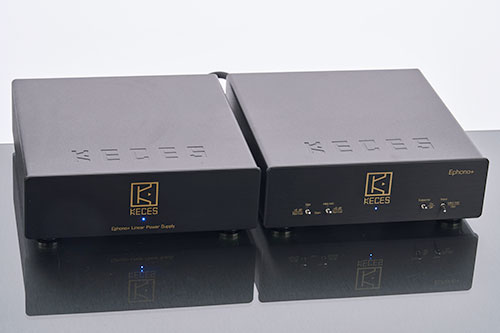This output stage is further linearized by the feedback loop of a discrete current feedback amplifier, which has a bandwidth of about 60 kilohertz at minus three decibels with open loop and almost one megahertz at minus three decibels with closed loop. The bandwidth of 60 kilohertz in the open feedback loop was achieved by a two-pole compensation method. This flattens the distortion in the audio spectrum as the open-loop gain drops off at higher frequencies compared to the typical Miller compensation. On the contrary, the large open-loop bandwidth mentioned does not exist in headphone amplifiers incorporating ICs.
In addition, the internal power supply is Hypsos' technological legacy. It features low-noise switching regulators with two-stage input and output filtering, followed by linear low-drop voltage regulators (LDO) with a fast transient response. For better channel separation, there are separate LDOs for both channels. Furthermore, the OOR features two DC inputs: a classic 2.5/5.5-millimeter DC jack plug and a 4-pin WEIPU plug, the same as on the Hypsos. To allow the use of the second option when purchasing a Hypsos, Ferrum includes with it a special power link cable with four-pin WEIPU connectors on both sides. When a normal cable is used, the "4-Terminal Sensing Design" (4TSD) feature in the Hypsos measures the voltage at the cable output, whereas with the FPL cable, the voltage is measured directly on the OOR’s main board. This allows the Hypsos to further stabilize the voltage in the current path.

There are eight independent main power rails in the OOR. For the amplifiers in the output stage, there are independent ±20 volt rails for both channels, based on low-noise, fast, linear low-drop voltage regulators. For the preamplifier stage, there are ±15-volt rails, also independent for both channels and based on linear LDOs. The ±20 volt rails of the LDOs are fed by switching converters that come up with two-stage filters at the input and output. The voltage at the output of the switching converters is approximately ±21.5 volts. Finally, there is an additional power rail just for the front LED, which is powered directly from the input power supply. The OOR features a six-layer circuit board. It has two layers just for the grounding surfaces. There are three groundings on the OOR: Signal ground, switching converter ground, and input power supply ground. These groundings and the power rails are separated by common mode chokes to further attenuate the high frequency common mode noise provenient from switching converters and the input power supply.

-
Keces Ephono+
Nein, ich werde mich ab sofort nicht mehr nur mit günstigen Hifi-Komponenten beschäftigen, auch wenn durch den Test des erschwinglichen Eversolo DAC-Z10 und des Ephono+ der Eindruck entstehen konnte. Denn obwohl Keces der Signalverarbeitung und dem Netzteil je ein eigenes Gehäuse spendiert, ist die Phonostufe für gerade einmal 1.200 Euro zu haben. Ich habe zwar gegenüber Komponenten mit moderaten Preisen genau so wenig Berührungsängste wie gegenüber solchen mit exorbitant hohen – wie sich Anfang des…23.12.2025 -
Galion Audio Navy Röhrenvorverstärker
Wir haben das röhrenbestückte Vorverstärker-Flaggschiff Navy des jungen kanadischen HiFi-Unternehmens Galion Audio unter die Lupe genommen. Der Line-Vorverstärker mit vier Doppeltrioden 12AT7 (ECC81) wartet nicht nur mit hochwertigen Bauteilen auf, sondern er ist das spannende Designprodukt eines high-fidelen Überzeugungstäters. Mir sagte der Markenname Galion Audio bislang wirklich gar nichts. Das junge Unternehmen aus Québec in Kanada wurde 2020 von Thomas Tan, einem passionierten Audiophilen, YouTuber („Thomas & Stereo“) und Content Creator, gegründet. Ziel war, seine…16.12.2025 -
Eversolo DAC-Z10
Meine beiden D/A-Wandler, der DAVE im Arbeits- und der HUGO TT2 im Wohnzimmer, werden serienmäßig von Schaltnetzteilen gespeist. Bei letzterem kommt seit einiger Zeit ein Ferrum Hypsos, bei Chord Electronics Topmodell ein lineares Dreifach-Netzteil zum Einsatz. Ein solches versorgt auch den Eversolo DAC-Z10 – zum Preis von 2.000 Euro. Und nein, es sind keine drei ausgelagerten Stromversorgungen, für die der genannte Preis gilt. Dafür bekommt man das vollständige Topmodell unter Eversolos DACs. Es ist schon…09.12.2025 -
Raidho X2.6 Standlautsprecher
Mit Lautsprechern von Raidho haben wir uns bei Hifistatement schon öfter beschäftigt. Im Fokus standen dabei die Kompaktlautsprecher TD1.2 aus der TD-Serie sowie X1t und X1.6. aus der X-Serie. Diesmal haben wir den Standlautsprecher X2.6 zu Gast, das aktuell größte Modell der X-Serie. Raidho verspricht, mit der X-Serie besonders viel Leistung – sprich Klangqualität – für den aufgerufenen Preis zu bieten. Wobei, „billige“ Lautsprecher – ganz gleich nach welchem Maßstab - hat Raidho noch nie…02.12.2025 -
Canor Virtus A3
Zur diesjährigen HighEnd stellte Canor den Virtus A3 Hybrid-Vollverstärker vor. Der lockt mit einem integrierten Digital-Analog-Wandler und einer diskret aufgebauten Phono-Vorstufe für MM- und MC-Tonabnehmer. Sowohl seine Technik als auch die Ausstattung bieten Ungewöhnliches. Vor allem aber soll er klanglich beeindrucken. Das slowakische Entwickler-Team konnte mich bereits vor einem Jahr überzeugen: Der Vollverstärker Virtus I2 aus der Premium Line musizierte in meinem Hörraum wie keiner zuvor in dieser Preisklasse. Der war ein gestandener Röhren-Vollverstärker. Auch…28.11.2025 -
Dan D’Agostino Progression S350
Dan D’Agostino ist eine Legende im Verstärkerbau. Er folgte wohl nie einer Mode, sondern vertraut bei allen Entwicklungen seinem Gehör und seiner Leidenschaft für den guten Klang. Mehr als 50 Jahre baut er nun schon Verstärker, immer mit dem Ziel, das „Wesen der Musik hörbar zu machen“. Erfüllt auch der S350 diese hoch gesteckten Ambitionen? Die Progression S350 ist die kleinste Stereoendstufe im Gesamtprogramm. Optisch trägt sie alle charakteristischen Merkmale einer echten D’Agostino. Angefangen mit…25.11.2025
© 2025 | HIFISTATEMENT | netmagazine | Alle Rechte vorbehalten | Impressum | Datenschutz

























 |
|
















































































